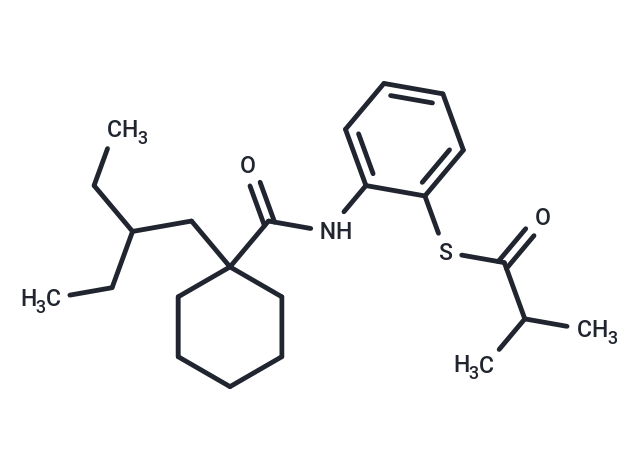Shopping Cart
- Remove All
 Your shopping cart is currently empty
Your shopping cart is currently empty

Dalcetrapib (RO4607381), a rhCETP inhibitor (IC50=0.2 μM), increases the plasma HDL cholesterol.

| Pack Size | Price | Availability | Quantity |
|---|---|---|---|
| 2 mg | $37 | In Stock | |
| 5 mg | $57 | In Stock | |
| 10 mg | $72 | In Stock | |
| 25 mg | $135 | In Stock | |
| 50 mg | $211 | In Stock | |
| 100 mg | $369 | In Stock | |
| 1 mL x 10 mM (in DMSO) | $57 | In Stock |
| Description | Dalcetrapib (RO4607381), a rhCETP inhibitor (IC50=0.2 μM), increases the plasma HDL cholesterol. |
| Targets&IC50 | CETP (recombinant human):0.2 μM |
| In vitro | Dalcetrapib modulates CETP activity. Dalcetrapib induces a conformational change in CETP, when added to human plasma. CETP-induced pre-β-HDL formation in human plasma is unchanged by Dalcetrapib ≤3 μM and increased at 10 μM. Dalcetrapib statistically and significantly increases pre-β-HDL formation. [1] Dalcetrapib achieves 50% inhibition of CETP activity in human plasma at a concentration of 9 μM. [2] Dalcetrapib inhibits the CETP activity of media in HepG2 in a dose-dependent manner. [3] |
| In vivo | Treatment with Dalcetrapib leads to significant increases in HDL-C levels. In hamsters injected with [3H]cholesterol-labeled autologous macrophages Dalcetrapib significantly increases fecal elimination of both [3H]neutral sterols and [3H]bile acids. Dalcetrapib increases plasma HDL-[3H]cholesterol. [1] Dalcetrapib has 95% inhibition of CETP activity in male Japanese white rabbits at an oral dose of 30 mg/kg. Dalcetrapib increases the plasma HDL cholesterol level by 27% and 54%, respectively, when given at oral doses of 30 mg/kg or 100 mg/kg once a day for 3 days to male Japanese white rabbits. [2] Treatment with Dalcetrapib markedly increases serum levels of HDL-C. The ratio of HDL2-C to HDL3-C is significantly higher in Dalcetrapib–treated rabbits than in control rabbits at 5 and 7 months, indicating that the inhibition of CETP activity by Dalcetrapib changes the distribution of HDL subfractions and preferentially increases HDL2-C levels. Dalcetrapib treatment increases serum paraoxonase activity and HDL-associated platelet-activating factor acetylhydrolase activity, but decreases the plasma lysophosphatidylcholine concentration. [4] |
| Kinase Assay | Inhibition of rhCETP and C13S CETP-mediated transfer of CE from HDL to LDL: The inhibitory potency (IC50) of Dalcetrapib to decrease CE transfer from HDL to LDL by rhCETP and C13S CETP is measured using a scintillation proximity assay kit. Briefly, [3H]CE-labeled HDL donor particles are incubated in the presence of purified CETP proteins (final concentration 0.5 μg/mL) and biotinylated LDL acceptor particles for 3 hours at 37 °C. Subsequently, streptavidin-coupled polyvinyltoluene beads containing liquid scintillation cocktail binding selectively to biotinylated LDL are added, and the amount of [3H]CE molecules transferred to LDL is measured by β counting. |
| Cell Research | The HepG2 cells are seeded in 6-well plates and cultured to 70–80% confluence. After being washed with PBS, the cells are incubated with growth medium and a different concentration (0 μM–30 μM) of chemical inhibitor Dalcetrapib and dissolved in 2% DMSO for 24 hours. Total RNA is used for RT-PCR.(Only for Reference) |
| Alias | RO4607381, JTT-705 |
| Molecular Weight | 389.59 |
| Formula | C23H35NO2S |
| Cas No. | 211513-37-0 |
| Smiles | CCC(CC)CC1(CCCCC1)C(=O)Nc1ccccc1SC(=O)C(C)C |
| Relative Density. | 1.066 g/cm3 |
| Storage | Powder: -20°C for 3 years | In solvent: -80°C for 1 year | Shipping with blue ice. | |||||||||||||||||||||||||||||||||||
| Solubility Information | DMSO: 72 mg/mL (184.81 mM), Sonication is recommended. Ethanol: 72 mg/mL (184.81 mM), Sonication is recommended. H2O: < 1 mg/mL (insoluble or slightly soluble) | |||||||||||||||||||||||||||||||||||
Solution Preparation Table | ||||||||||||||||||||||||||||||||||||
DMSO/Ethanol
| ||||||||||||||||||||||||||||||||||||

Copyright © 2015-2025 TargetMol Chemicals Inc. All Rights Reserved.